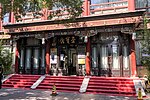Roman Catholic Archdiocese of Beijing
1307 establishments in Asia1375 disestablishments14th-century establishments in ChinaDioceses established in the 14th centuryOrganizations based in Beijing ... and 6 more
Organizations established in 1690Religion in BeijingReligious organizations established in the 1690sRoman Catholic dioceses and prelatures established in the 17th centuryRoman Catholic dioceses and prelatures established in the 21st centuryRoman Catholic dioceses in China

The Roman Catholic Archdiocese of Beijing (Latin: Archidioecesis Pechimensis) is a Metropolitan Latin archdiocese in the People's Republic of China.
Excerpt from the Wikipedia article Roman Catholic Archdiocese of Beijing (License: CC BY-SA 3.0, Authors, Images).Roman Catholic Archdiocese of Beijing
Xicheng District Xichang'anjie (首都功能核心区)
Geographical coordinates (GPS) Address Nearby Places Show on map
Geographical coordinates (GPS)
| Latitude | Longitude |
|---|---|
| N 39.900798 ° | E 116.374075 ° |
Address
100032 Xicheng District, Xichang'anjie (首都功能核心区)
Beijing, China
Open on Google Maps









